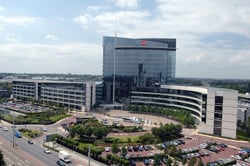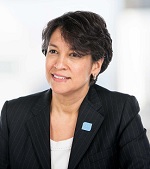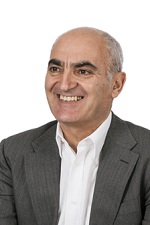 |
| GlaxoSmithKline's corporate headquarters in Brentford, London--Courtesy of GlaxoSmithKline |
Hobbled by sliding sales of Advair, GlaxoSmithKline's U.S. group started to chop away at its large organization in North Carolina and Philadelphia on Wednesday as Glaxo's North American chief Deirdre Connelly began to outline exactly where the ax will fall.
The company ($GSK) says that the bulk of the job cuts will be made in Research Triangle Park, NC, slashing R&D as it concentrates drug research work in Philadelphia and Stevenage in the U.K. No exact numbers were reported today by GSK, but the company filed a report with the state noting that it is eliminating 900 jobs.
A total of 350 of those jobs will go in the first quarter of 2015, with another 450 following in the next three months, GSK noted in its WARN letter. The rest will be pink-slipped later in the year.
But GlaxoSmithKline added that not all the people involved will be terminated. An uncertain number will be relocated to other company facilities, and as many as 450 could get jobs with a supplier--an apparent reference to a deal it is doing with Parexel. On the chopping block: chemists, engineers, biologists, clinical development scientists, statisticians and more.
"Some R&D roles will be relocated to the Philadelphia area and some staff will be offered relocation," the company said in a statement emailed to FierceBiotech. "We will be working with local employers to support staff securing re-employment. In the US, we are reshaping and reducing the size of our commercial and R&D operations (now 17,000 employees) to be more agile to flex with shifting market demands. Cuts are not being made across the board but are strategic, focused changes to allow GSK to operate more efficiently. This is not a change in our strategy, which has helped us deliver more new medicines than any other company in the industry in the past 18 months. This is a rescaling of work to reflect market forces that were anticipated but that have accelerated and are affecting the entire industry."
The pain will also be spread through Philadelphia and staffers spread out in the U.S. market. "The reduction of jobs in our US Pharmaceuticals business will affect employees in Philadelphia, RTP and the field," GSK noted. "Retail sales teams focused on launching new medicines to the market will largely not be affected. Our proposed changes to R&D will sharpen the focus in discovery and development and reduce funding in certain areas of the pipeline."
 |
| GSK North American Chief Deirdre Connelly |
GSK says it has 4,300 staffers in the area with about 2,500 devoted to R&D.
Responding to a query from FierceBiotech, a GSK spokesperson says it has also "signed a letter of intent with the CRO Parexel to create a GSK unit here in RTP. It's only one element of a broader restructuring of the business which also includes the transfer of several thousand employees from Novartis to GSK when that transaction is completed, which is expected in H1 2015."
GlaxoSmithKline chief Andrew Witty stunned longtime company insiders recently when he announced that the pharma giant would slice $1.6 billion out of its annual budget. The company subsequently focused heavily on the U.S. side of the business--starting a unit-by-unit review--after its new respiratory drugs Breo and Anoro have failed to live up to initial sales expectations.
 |
| Moncef Slaoui |
The shakeup comes 6 years after Moncef Slaoui unveiled a new strategy in its R&D arm, breaking up its investigators into smaller, more "biotech-like" groups called drug performance units, or DPUs. The R&D budget was rebalanced, shifting money from discovery to development and putting an emphasis on their ROI instead of the percentage of sales devoted to drug research.
Initially, the pharma giant boldly declared that the researchers would gamble their careers on the drugs they chose to develop, with a three-year runway to succeed or fail. But failure rarely led to the exit as Slaoui preferred to reassign and refocus teams on new drugs.
Over the course of that revised R&D game plan, GSK did manage a burst of new drug approvals in 2013. But many of the new drugs were only marginal players that could never fill the hole being left by declining sales of Advair. New drugs that might have offered a blockbuster return--the cancer vaccine MAGE A-3 and the heart drug darapladib--flopped in the clinic. And Slaoui was left to focus on vaccines while R&D's number two--Patrick Vallance--took charge of drug research.
Meanwhile, on the marketing side, charges of corruption in China tainted CEO Andrew Witty's repeated assertion that the company had cleaned up its act after past transgressions.
Last year GlaxoSmithKline spent $6.58 billion on R&D, the 7th ranked Big Pharma spender in the industry. That amounted to 14.5% of sales. And a large portion of its oncology R&D group will head to Novartis ($NVS) in a swap of assets.